| THE INDUSTRIAL RAILWAY RECORD |
© SEPTEMBER 1967 |
![]()
LONGMOOR MILITARY RAILWAY
In my youth I spent many holidays at Liss and remember the gradual extension of the railway from Longmoor to Liss. The construction was undertaken by members of the Territorial Army during their annual training and progress was accordingly slow. During 1930 THISBE was the engine on the construction train; this was the ex Shropshire & Montgomeryshire 0−6−2T built by Hawthorn Leslie (2879 of 1911). When looking in at Longmoor Depot in September 1934 I was most fortunate in seeing 3239, the Hunslet 2ft gauge 4−6−0T (see RECORD 3, page 82), which had arrived that day from Gosport on a W.I.M.R. flat wagon. My pictures taken in September 1934 show a Liss-bound train approaching Liss Forest Halt behind EARL ROBERTS (Crewe 3165 of 1891 – ex LMSR 6610) and the same locomotive at the halt platform.
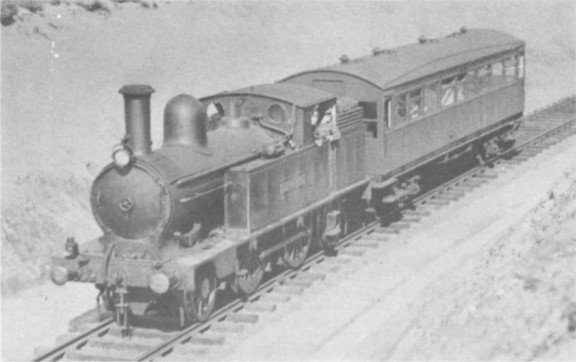
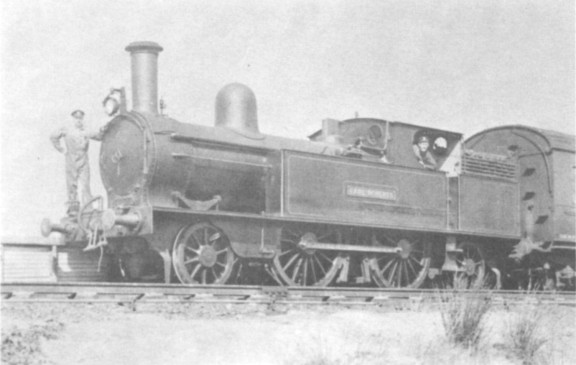
| UPPER NORWOOD, LONDON S.E.19. |
Yours etc., G. ALLIEZ |
LOCOMOTIVE BUILDERS' WORKS LISTS
I was particularly interested to see the works list for the Worcester Engine Company (page 309, RECORD 12) and would like future issues to feature similar lists for other small builders of industrial locomotives. At present I am compiling an account of the steam locomotives of Walker Bros., of Wigan, and would be pleased to hear from any reader who can help.
| RAYLEIGH, ESSEX. |
Yours etc., J. MORLEY |
(Contributions of this nature will be most welcome. In active preparation are articles dealing with the steam locomotives of E.E.Baguley Ltd., and the steam and internal combustion locomotives of Ruston Proctor and Richard Hornsby. We would ask readers with information relative to these firms to contact us. – Hon. Eds.)
A SPANISH INDUSTRIAL RAILWAY
Last summer I was in Bilbao for a few days so I took the opportunity to see some industrial lines in the area. Together with a friend of mine I set out to try and find the 3ft 9¼in gauge FC de Sestao a Galdames (Sestao-Galdames Railway). We took the electric railway and succeeded in getting off at the wrong Sestao station (or maybe it wasn't Sestao at all), but after a long walk through complicated suburbs and an unlit road and railway tunnel we found ourselves near the river bank and at the railway's headquarters. Right in front of us an 0−4−0 saddle tank (No.10, Manning Wardle 658 of 1877) was shunting wagons into a siding with some sort of tipping gear at the end. In the nearby – rather overgrown – yard some old wagons and carriages, two sets of engine frames, obviously from two of No.10's sisters, and a hand operated crane were living a life of idleness. At the far end of the yard were the company's repair shops and running shed containing several Kitsons and Manning Wardles in various states of repair and disrepair.
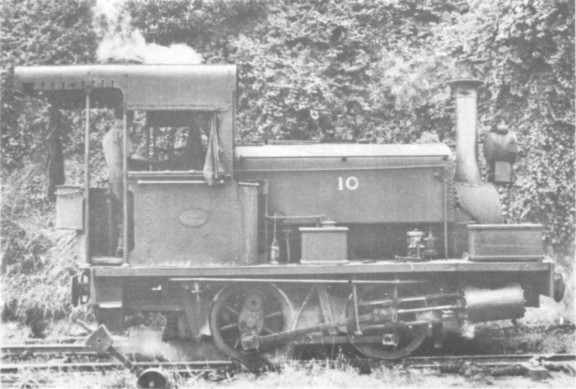
In a siding near the tipping gear we found 4−6−0 side tank No.3, Kitson 1902 of 1873, being prepared for its next trip up the line. Twice a day the Manning Wardle runs a passenger service for workers at the local steelworks. There were three carriages in use at the time we were there; these were rebuilt from older parts, having new frames and bodies. On the frames was A.H.V. 1949 (Altos Hornos de Vizcaya) this being the year when these came from the rolling mills. Two very small coaches with the entrance on one side only and a sort of directors' coach formed the rest of the passenger stock. All were four-wheelers, as were the wagons, which had been converted from tippers. Altogether it was quite a pleasant railway and I would like to know more about it, especially about its engines.
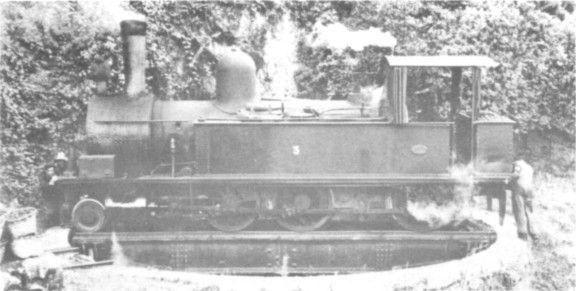
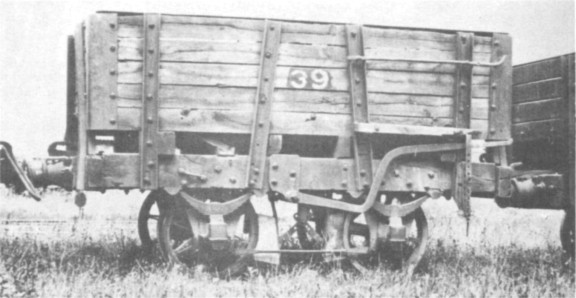
| SCHEVENINGEN, HOLLAND. |
Yours etc., R.J. BRETTSCHNEIDER |
(We are pleased to publish this letter from one of our new overseas members, written in such excellent English that it did not require the editorial "blue pencil". Perhaps our Spanish experts can tell us more. – Hon. Eds.)
COCONUTS, CANE AND COFFEE
I was interested in this article in RECORD 13 and can add a little to the information given. No.8 of Agricola do Cassequel was a 4−wheel gas locomotive, 60cm gauge, weight 8 U.S. tons, model 8GM−22, built by Whitcomb in April 1939, construction number 13174. This locomotive was actually ordered from Baldwin's who sub-contracted it to their subsidiary company, Whitcomb; a Baldwin number was allotted, however – XO 3015 of 1939.
"XO" means extra order and the series began at 1 each year. All spare parts sold to customers – from nuts and bolts to new boilers – were given an XO number, and this series included locomotives not built by Baldwin. Many of the Whitcomb 65 ton diesels used by the British War Department in the Middle East during the Second World War had XO numbers. Large items in the XO list usually had a plate with the date and XO number, the most commonly seen being new boilers.
I've gone thru my complete Whitcomb list but can find no others for Agricola do Cassequel, nor can I trace the Plymouth locomotive. Both Whitcomb and Plymouth received large block orders for small units from the French Supply Commission and other relief agencies, but little is known about them as records do not show where they were shipped.
| NEW YORK, U.S.A. |
Yours etc., H.L. GOLDSMITH |
(Whitcomb 13174 may be one of the diesel locomotives at this company's factory at Bom Jesus. See the letter from Frank Jux in this issue. – Hon, Eds.)
* * *
I read Mr Rickwood's article with considerable interest and can add some extra notes. The latest edition of "Angola Portos e Transportes" shows some photographs of the Cuio line, which has an 8km branch apart from the 28km main line. The locomotives illustrated appear to be Hunslet and Schottler diesels with a continental-type steam locomotive on shed. The Companhia do Assucar de Angola has another factory at Tentativa, north of Luanda, with three Orenstein & Koppel steam and nine diesels. The Sociedad Agricola Cassequel Limitada also has a further factory at Bom Jesus, south of Luanda, again reputed to have steam and diesel locomotives.
I did manage to visit Luanda CFA workshops and as a result have a few more queries. Firstly CFA No.1 was in small pieces, ostensibly for overhaul prior to preservation, so I did not see it. (Possible location is the SECIL cement factory which was not visited. Secondly in the workshop yard was a 60cm end balcony coach and a tiny Decauville 0−4−0 side tank, both said to have come from the Golungo Alto branch, but the Decauville locomotive is too small for any serious work. The branch is said to have been completed in 1915 but the earliest locomotives listed by Mr Rickwood were built in 1922. What worked it in the interim period? All most intriguing.
| RICHMOND, SURREY |
Yours etc., F. JUX |
Reading Colin Pealling's letter on page 311 (RECORD 12) brought to mind an experience I had when carrying out research into the Strakers & Love locomotives at Brancepeth Colliery. The Plant Records Clerk put me in touch with an old man who had been a watchman there in the 1930's. He remembered MEADOWFIELD (Fox Walker 289 of 1874) well – too well. During the period she was being cut up he came across some boys one night lighting a fire in the firebox. Having chased them away he ran off for some water which he promptly threw on the fire. Unfortunately this caused a blow-back, and he was badly burned. It was a bad day for the family altogether for his father-in-law died the same evening. So home to ask his wife when her father died and we have the scrapping date of MEADOWFIELD – 29th March 1934.
| DURHAM. |
Yours etc., COLIN E. MOUNTFORD |
I have been able to identify the Whitcomb diesel at the Carrigcannon bog which was mentioned on page 5 of RECORD 13. Ordered by James Motley & Company and numbered 12, it was built by Whitcomb in November 1945, construction number 40331. The records do not show the Whitcomb class but it was a 4−wheel diesel mechanical with a weight of 5 U.S. tons.
| NEW YORK, U.S.A. |
Yours etc., H.L. GOLDSMITH |
(Mr Semmens has been advised by Bord Na Mona that T.A.E. (page 5) and BANGOR ERRIS (page 6) are located in Co. Mayo (not Co. Galway). On page 4, "Leo McTurk" should read "Leo McGurk"; also Western Industries (Boyle) Ltd, is in Co. Roscommon, and not Co. Wicklow. – Hon. Eds.)
LONGMOOR MILITARY RAILWAY
With reference to Mr Jeynes' letter on page 306 (RECORD 12) my records show that GORDON was withdrawn by the GWR on 30th December 1926 and arrived at South Hetton on 27th January 1948. The boiler was condemned in October 1959 and GORDON was "withdrawn" in October 1960; went to Caerphilly on 29th January 1962 (where she was the last locomotive in the works and on to Swindon on 24th June 1963.
GORDON is almost exactly as it was in TVR days excepting a few minor detail alterations and since October 1966, when 0−6−2T No.53 (Cardiff 302 of 1894) was scrapped at Philadelphia, is "the only surviving example of locomotive designing and building of totally Welsh origin".
| DURHAM. |
Yours etc., COLIN E. MOUNTFORD |
TRACTION ENGINES AS LOCOMOTIVES
I think it might be of interest to readers to know that there is a photograph of the other side of the engine illustrated in RECORD 7 (page 145) on page 152 of Floyd Clymer's book "Album of Historical Steam Traction Engines, No.1." The engine is briefly described as built circa 1880, and used for years in the Mother Lode mining region; and that the photograph was taken at Angel's Camp, California, in 1948. Although it is only a small photograph, the clips and bolts attached to the offside rear wheel can be seen, while the nearside rear wheel has no such wooden attachments. The reason for the steering gear is apparent, as the engine is not on rails in this photograph. The cylinder is mounted with its centre roughly on the centre line of the boiler, the motion inclining upwards to the crank disc. Another point of interest is that the link motion derives its motion from a double return-crank mounted outside the big end on the crank pin. The smokebox door is hinged horizontally just above the centre line of the boiler, while there are a couple of brackets facing forward which may have been fulcrum point for a crane jib at some time.
In conclusion I would give my opinion that this engine was built up around a portable engine or traction engine exported from this country, for the firebox, steering chain drum and steering gear brackets are typically British practice. The single row of rivets in the horizontal boiler seam would be against the supposition that it originally worked at 180 lbs/sq in for the cylinder is not lagged.
| NEWCASTLE-ON-TYNE. |
Yours etc., E.H. JEYNES |
* * *
I was interested in the article on STEAM SAPPER No.5 in RECORD 12 and recall reading somewhere (possibly in "The Engineer" or "Engineering") that some of the Steam Sappers when delivered new were put straight to work by the War Department in building Aldershot. After a road had been cut on the virgin heath the Steam Sappers hauled wagons from the supply railhead at Tongham. I understand that Aldershot was built in the 1870's and why supplies did not go to Aldershot station (opened in 1870 rather than Tongham I do not know. Perhaps I'm trying to think of the other Steam Sappers built in the 1860's?
As the headquarters of Military railways until Longmoor was thought of, the Chattenden & Upnor Railway would get all the locomotives and traction engines that the War Department was not using for a time.
| LONDON, N.W.11. |
Yours etc., P.M. KALLA-BISHOP |
SIR BERKELEY
Many readers will know that this vintage Manning Wardle (1210 of 1891) is now preserved on the Keighley & Worth Valley Railway, having left the Byfield Ironstone Quarries on 19th January 1965. May I appeal to RECORD readers for photographs and details of SIR BERKELEY as I am compiling a comprehensive biography for eventual publication in book form.
| DUDLEY, WORCS. |
Yours etc., R. CROMBLEHOLME |
DAMAGING A LOCOMOTIVE ENGINE
With reference to this article in RECORD 13 some notes on the construction of the GWR branch to Chard may be of interest. In December 1863 the local press reported that the contractors were making good progress, despite bad weather, and that the line was sure to be finished within the twenty months allowed. The same statement, with the last part discreetly overlooked, was repeated at intervals, culminating in February 1866 with a report that the line would be ready by May of that year. In fact it was not ready by September. From the details of the Manning Wardle locomotives it is clear that the contractors' line was of standard gauge, and it seems that no broad gauge tracks were laid until April 1866, when tracklaying is reported to have begun at Chard. It seems strange that the broad gauge was not laid from the Taunton end, so that broad gauge trains could bring along materials, and the contractors' locomotives retreat over the LSWR line when the job was finished.
Other locomotives used on railway contracts in this part of the country include Brassey's TRIO, which was used on the construction of the Salisbury and Yeovil line in the late 1850's. According to Part 1 of "Locomotives of the LSWR" (RCTS) this was an 0−4−2 ballast engine built by John Jones (Vulcan Foundry, Newton-le-Willows, Lancs.) and delivered to the London & Southampton line in January 1838, and later taken over by Thomas Brassey on 4th November 1839 when he contracted to maintain the permanent way of the London and Southampton Railway (by then retitled the London & South Western Railway).
The Salisbury and Yeovil contract seems to have been one of its last jobs, and it is recorded as being at work in the Yeovil area as late as April 1860. Brassey did not gain the contract for the whole of the Exeter line, the section west of Yeovil being built by James Taylor of Manchester. His first locomotive was delivered to Honiton on 29th May 1857, when it was drawn through the High Street by sixteen horses. Another was delivered to Crewkerne late in April 1858 and was the cause of much trouble before it came in sight of the tracks. It began by falling into a gutter, and after being rescued, followed this up by dragging the contractor's brother twenty yards on his back, caught up in the harness.
In July 1859 Taylor advertised the sale of his plant to take place in September or October (although this must have been delayed, as the line was not ready until 1860). Included in this were four locomotives, at least one of which had a tender. The directors of the LSWR made a tour of inspection in August 1859 when these locomotives were working on isolated sections of track at Crewkerne, Chard Junction, Seaton Junction and Exeter, the only gap between the last two being Honiton Tunnel which had not been completed at that time.
| YEOVIL, SOMERSET. |
Yours etc., MICHAEL J. O'CONNOR |
* * *
With reference to the final paragraph of your footnote on page 32 of RECORD 13, I think it is clear from MacDermot's History (Vol.2 – original edition) that the Chard branch was never of mixed gauge. It was completely against the policy of the GWR to let it be so, in case the hated LSWR should then apply to Parliament to give them running powers to Taunton. Even when a joint station was built at Chard the two gauges were kept separate (footnote to page 167), and in Grierson's scheme of 1878 to convert broad gauge branches to mixed gauge the Chard branch (vide page 326) was specifically excepted for fear of such action by the LSWR, and it was in fact not converted to narrow (i.e. standard) gauge until almost the last moment (July 1891), long after the other branches had been so treated.
I feel sure that MW 79 was standard gauge and I suggest that the construction of the line, earthworks, bridges etc., could easily have been carried out by laying a standard gauge line along the alignment, even as far as but not connecting with, the main line at Creech Junction. Then when all was ready the broad gauge metals could have been laid, perhaps with the standard gauge line in between them temporarily. To have used one of the broad gauge rails would have caused uneven wear. and I doubt if the GWR, in their suspicion of the LSWR motives would have ever allowed it. Admittedly that would mean that magistrate Badcock's words "if he had driven on the main line" were a rhetorical exaggeration, and even if defending counsel had realised that this was so. it would have done his client no good to point it out – in fact he might have annoyed Badcock by doing so – as the charge was one of wilful damage to the locomotive and not one of endangering the public. I think too, that there was some excuse for Badcock's mistake. To him the branch was just "another damned railway" and there is no reason for him to have known that the contractor was using a line of a different gauge in its construction. He is hardly likely to have visited the construction works, and even if he had I doubt whether he would have noticed any difference in gauge. Even in these enlightened days one meets people still more ignorant of railway operation than he seems to have been! After all, one is talking of matters of 100 years ago, when railway enthusiasts could probably have been counted on the fingers of one hand.
I am sure that you will excuse my writing at such length, but I have a fatherly interest in BUSY BEE seeing that it was I who wrote the less factual and more flippant story in the "Railway Observer", taken from another Somerset newspaper.
| MINEHEAD, SOMERSET. |
Yours etc., A.N.M. GARRY |
I am pleased to let you know that the Science Museum has now photostatted Merryweather's 1882 Catalogue of Steam Tramway Engines. The pages are copied two on one sheet. and the whole lot costs nineteen shillings.
The wording on the title page reads:- Catalogue of Steam Tramway Engines. For Street Traffic; Light Locomotives; For Contractors, Collieries, Quarries and Plantations; and Tramway Plant of every description. There is an engraving on page 25 of a very small outside cylinder 0−4−0 saddle tank described as a "small locomotive suitable for Portable Railways and other purposes. Price from £250 each." On the same page are illustrations of contractors' wagons available from £6−10−0 each.
Is there any information available as to whether this firm built locomotives other than tramway and 0−2−2 inspection types?
| OLD BOTLEY, OXFORD. |
Yours etc., R. ABBOTT |
AN UNUSUAL LOCOMOTIVE
Apropos Mr Leleux's article in RECORD 13, I visited both the Davis works in 1958 and can add a little information.
At Neasden on 15th March the locomotive was as illustrated and bore a works plate "Designed and Constructed by Arthur Cudworth, St. Mark's Engineering Works, Wrexham" which was affixed upside down (and is visible on F. Jones's photograph). The boiler, by Farrar of Newark, was dated 25th October 1943.
At Langwith Junction on 14th December the locomotive was generally similar and again the wheels were not coupled. No works plate was visible but if carried in the same position would no doubt be covered by the more extensive "cab". I enclose a photograph taken at the time, in very dull weather as is all too evident.
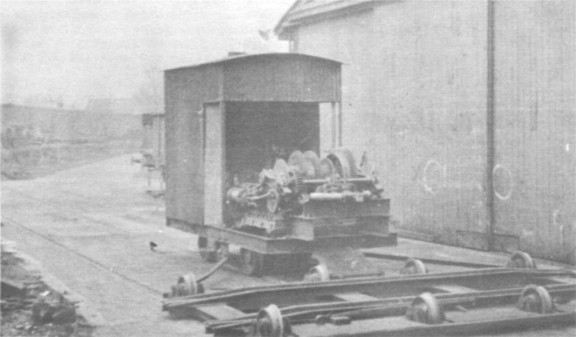
I would opine that both these locomotives were largely constructed from standard steam crane components.
| BLURTON, STOKE-ON-TRENT. |
Yours etc., J.K. WILLIAMS |
I was very interested to see the photograph on page 18 (RECORD 13) of no.46 (John Fowler 4950), as I thought at first it might provide a clue to enquiries I am making about some Fowler locomotives for the Mashonaland Railway. It did not help, but I think I have identified No.46 beyond reasonable doubt. The date of JF 4950 would be 1884/5, as JF 4995-4996 were Brecon & Merthyr Railway Nos. 1 and 2 of August 1885. Looking through my notes, I find that the Nitrate Railways Co. Ltd. (Ferrocarriles Saliteros), a British company operating in Chile, had eight 4−6−0 side tanks from John Fowler in 1884 for working on 4ft 8½in gauge. They had 4ft 0in driving wheels and 18in by 24in outside cylinders and their numbers were 42 to 49. If No.46 was 4950. it is possible that the works numbers for the series were 4946 to 4953. The chairman of the Nitrate Railways Company was Colonel North who at one time was employed by Fowler's. Probably as a result of this association three other batches of locomotives were built by Fowler's for this company as under:-
| Nos.3 to 8 | 0−4−0ST | 1876 | OC | 12in by 18in | 3ft 3½in wheels |
| Nos.50 to 61 | 2−6−2T | 1886 | OC | 18in by 24in | 4ft 0in wheels |
| Nos.67 to 70 | 0−6−0ST | 1897 | OC | 16¼in by 20in | 3ft 6in wheels |
I am still wondering whether these 4−6−0 tanks might have provided the basic design for the two 4−6−2 side tanks (JF 7450 and 7451) which became Mashonaland (later Rhodesian) Railways Nos.5 and 6, although the gauge was aft 6in and the cylinders 18½in by 20in. This much is certain, the MR locomotives were not designed specially for them. If anyone can provide any more information, I would be grateful.
An illustrated article on the Nitrate Railways appeared in "The Locomotive" for 1932, pp.85, 126 and 160 but unfortunately no works numbers are quoted.
| RICHMOND, SURREY. |
Yours etc., W.H.G. BOOT |
(Our member J.W. Lowe also sent along the same information and confirms the works numbers to be 4946 to 4953. – Hon. Eds.)
CHRISTMAS AT SWANSCOMBE
Since my article appeared in RECORD 12 I have come by details of the early history of Swanscombe Cement Works in "Limes, Cements, Etc.", a book by Colonel Pasley published in 1838.
The works was begun by a Mr Frost who obtained possession of the ground to the north of the London Road in 1825. Pasley says that "I was well acquainted .... with Mr Frost who had actually established a manufactory of artificial stone and cement near Northfleet before I commenced operations." (i.e. prior to 1826.) Pasley continues: "The flint mill, chalk mills, wash mill and grinding mills .... were all worked by a 30hp steam engine which Mr Frost erected for the purpose, and he also built a wharf on the Thames with which he communicated by a railway upon a raised road constructed by him across the intervening marsh for the use of his works which are close to the London Road on the north side of it and to the eastward of Ingress Park with a lane between."
Thus the railway at Swanscombe would certainly have been in operation by 1830 being presumably of 3ft 5½in gauge. Together with most of the early cement manufacturers, Mr Frost was something of an individualist. If he had no especial experience of railways, he might well have thought that outside flanges – a feature thought to be unique to Swanscombe – on the wagon wheels (and later, on the locomotives) were a suitable way of maintaining a good horse road between the rails, the early railways being solely horse-worked.
Pasley "did not approve of the system that had been adopted by Mr Frost .... of passing not only his chalk but his clay through the washmill and afterwards drying the mixture by long exposure to air .... " and it is thought that, when Francis & White purchased the works in 1833, the system was modified so as to be more in accord with the then-current practice.
Francis and White were originally styled Francis & Sons, having a cement works at Nine Elms, London, that was eventually removed in favour of the original London & Southampton Railway terminus. After 1833, the firm became Francis, White & Francis, but this was dissolved amicably on 1st January 1837 and two firms were formed. Francis & Sons took charge of the Nine Elms works, and Bazley' White and Son of Millbank, this latter retaining Mr Frost's original works.
Under the ownership of this firm, Swanscombe was considerably modernised; locomotives were introduced on the railway but horse haulage was retained in the quarries. It was not until 1900 that the works was acquired by the Associated Portland Cement Manufacturers (1900) Ltd.
| NEW MALDEN, SURREY. |
Yours etc., C.G. DOWN |
I was interested in the references on pages 73 and 74 of RECORD 14 to the YE locomotives which were undoubtedly the first in this country to have Belpaire fireboxes, and among the first with Walschaerts motion. I consider them the first "modern" narrow gauge locomotives in this country in having outside frames and valve-gear, and Belpaire fireboxes. Incidentally, "inspirators" are injectors; inspirators being the name adopted in America to distinguish the "self-starting" variety from the original Giffard pattern. These "inspirators" were mounted on top of the tanks of the Lodge Hill locomotives.
| KENILWORTH, WARWICKS. |
Yours etc., C. R. WEAVER |
(We have just located the following extract in the issue of "Iron" dated Saturday 29th May 1875: "A detachment of non-commissioned officers and men of the Royal Engineers, commanded by Lieut. Barker, on Saturday left the School of Military Engineering at Chatham for Upnor, where they will be quartered for some time, as they are to be employed to lay down lines of rails to connect forts on the Thames and Medway with the new powder magazines to be constructed at Chattenden Roughs, a few miles from the old magazines at Upnor Castle. It is expected that more than forty miles of these railways will be constructed." – Hon. Eds.)
* * *
My curiosity was aroused by the statement on page 290 (RECORD 12) that two 2ft 6in gauge locomotives (Bagnall 1513 and 1514 of 1897) went to the LH & UR about 1901 from the War Department, South Africa. The War Office has done some odd things during wars in, shall we say, misguided enthusiasm, but it does sees curious that these two Bagnalls should have been in South Africa.
The South African "standard" gauge is 3ft 6in and during the Boer War the then Cape Government Railway and Central South African Railway had plenty of motive power. Many lines were out of use owing to the sieges of Kimberley and Mafeking, apart from the Ladysmith siege and other troubles on the Natal side of the Transvaal. Years before the Boer War there had been Oft 8½in gauge and even 7ft gauges in use, and about 1902 the CGR started a 2ft gauge branch line. Some 2ft 6in lines existed in German South West Africa (as it was until 1914) but WD locomotives would not have gone there!
I should be most interested to learn more about the whereabouts in South Africa of these two Bagnalls.
| FISH HOEK, CAPE, SOUTH AFRICA. |
Yours etc., ANTHONY H. CROXTON |
I have a feeling your suggestion on page 310 (RECORD 12) that ELECTRIC No.1 was delivered new to the Sunderland District Electric Tramways could be correct. 1905 would be about the right date for the Power Station as the houses nearby ("Voltage Terrace" and "Electric Crescent"!) seem to date from that period. It could be that a Lambton locomotive shunted the power station (since Lambton coal would be used) and that ELECTRIC No.1 was bought by the SDET in 1919 to do this shunting; when the trams stopped in 1925 the whole lot could have passed to LHJC – but I have no definite evidence of this.
In Mr Charlton's letter it should be noted that 51 arrived at Philadelphia in June 1947 (ex Antwerp) as the Northern Division spare locomotive. Robert Stephenson 1919 was No.5 Area's No.40 (printed in error as 30 – Hon. Eds.), and should not be confused with R.& W. Hawthorn 1430 (ex LHJC 37) which was allocated 40 in the No.6 Area list – but never carried it. It is out of sequence with the other LHJC locomotive to come into No.6 Area, which became 31, because numbering was carried out in group order within the Area and 37 (alias 40) had moved to "C" group by this time.
It is curious that the No.5 Area Records at Beamish Hall show No.40 in the book list as " – 9537/1918 10/1949" for there is little doubt that ELECTRIC No.1 (Dick Kerr 9537 of 1918) went in 1934. The entry is blank apart from these figures; no maker is given and "10/1949" is the disposal date. Since our Hon. Records Officer reports that 37 was seen at Philadelphia (No.2 Area) in 1950/51 – can the observer confirm this, please? – I have always assumed that 37 should have become No.40 of No.2 Area, and that "10/1949" was the date it was transferred. But it is most curious that the maker's number of the Dick Kerr locomotive should crop up in the No.6 Area list if it never went to Tanfield Lea and had been scrapped 13 years before.
| DURHAM. |
Yours etc., COLIN E. MOUNTFORD |
FOX WALKER TRAMWAY LOCOMOTIVES
With reference to the letter in RECORD 13 (page 34) my records show that the first section of the Rouen tramways was opened on 30th (not 29th) December 1877, the second in June 1878 and the third in September 1878. Of the ten Merryweather tram engines supplied by 1881, six had 6in by 9in cylinders and four had 7in by 11in. Mr I.A. Wright, Rouen tramways engineer and general manager wrote to Merryweather's on 14th December 1881 to say that all the locomotives had given great satisfaction over the last four years. "We have altogether 23 locomotives, 10 of yours and 13 of other builders (both English and French and our experience is that those built by you are superior in every respect, particularly in economy in steaming and in repair."
Considering the above it is strange that horse traction replaced them in 1883.
| COSBY, LEICESTER. |
Yours etc., J.W. LOWE |
(We imagine that the discrepancy in opening dates of the Ronen Tramways would be that one was the occasion of the ceremonial opening and the other the day when public services commenced. – Hon. Eds.)
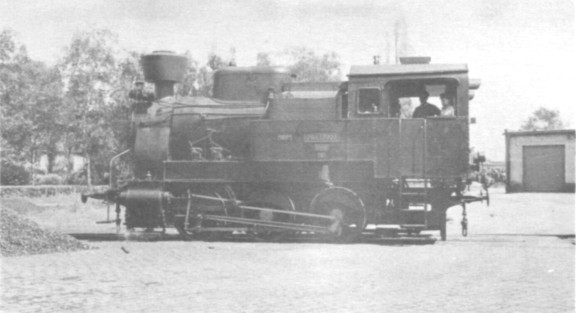
No Irish holiday is complete without a visit to the Guinness Brewery in Dublin (whether you are a railway enthusiast or not!), and it seems that the Prazdroj Brewery in Pilsen comes in the same category for those touring Czechoslovakia. On 3rd June 1960 D. Trevor Rowe was escorted round by a female English-speaking guide who was rather surprised when he chased off after the locomotive (1842 PRAZDROJ, 0−6−0 well tank, built by Českomoravská-Kolben-Daněk A Sp in Prague in 1929, works number 14). When she caught up it was stopped and the photograph above obtained. Unfortunately the locomotive was scrapped in 1963, and future enthusiasts who visit the Brewery will have to concentrate on the firm's products alone.